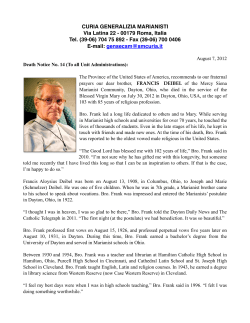
Document 244726
Scientific needs for high quality, intercalibrated datasets of CnHoXpYq or: Why bother? Roland von Glasow School of Environmental Sciences University of East Anglia Tropospheric chemistry Inorganic gas phase halogens in BL (incl. volcanic plumes, salt lakes) ? BrO(, Br2, BrCl) Ix Clx Halogens in the free troposphere comparison balloon-borne DOAS vs. ground and satellite derived vertical column vs. stratospheric model: tropospheric BrO column of 1-3 x 1013 molec cm-2 ≈ 0.5 – 2ppt (Harder et al. 1998, McElroy et al. 1999, Frieß et al. 1999, Pundt et al. 2000, Wagner et al. 2001, Richter et al. 2002, van Roozendael et al. 2002, Fietkau et al. 2007, Hendrick et al. 2007) molec/cm2 BrO conc. 107 molec cm-3 Fitzenberger et al., 2000: 0.5 – 2.5 pmol mol-1 satellite (GOME) - balloon ground-based MAX-DOAS altitude (hPa) O3 reduction due to bromine chemistry 0.82-0.84 <0.8 latitude annual average von Glasow et al., ACP, 2004 Yang et al., JGR, 2005 Biogenic Br precursors Increase in inorg-Br due to VSLS (in pmol/mol): ~600 GgCHBr3/yr additionally: CH2Br2 CH2BrCl CHBr2Cl CHBrCl2 Nicola Warwick, Cambridge, SOLAS Newsletter, Winter 2007 113 Gg/yr 7 Gg/yr 23 Gg/yr 16 Gg/yr Appledore Island Mace Head Tropospheric chemistry • Bromine – MBL BrO: largely sea salt – FT BrO: could be very important for oxidation capacity • sea salt key precursor in MBL and partly in FT • org-Br: lifetime order of weeks Î effect NOT close to source but regional to hemispheric • Iodine – MBL, coastal regions: I2 key precursor – MBL, open ocean (gas phase IO, aerosol enrichment): likely org-I key precursor, lifetime of minutes (CH2I2) to minutes/hours Î effect fairly close to source – free troposphere, UT/LS??? no positive identification of inorganic gaseous iodine so far Stratospheric chemistry WMO, 2007 Bry calculated from balloon DOAS BrO total column BrO above 15 km from SCIAMACHY with BrO partial columns from the AER 2-D model, WMO, 2007 CHBr3 Butler et al., 2007 Quack and Wallace, 2003 Stratospheric iodine??? • How much is there? • Is it increasing due to human activity? • Tropical (vertical) iodine mass balance is not understand Summary • Troposphere – FT Br might be dominated by org-Br – open ocean I might be dominated by org-I – lifetime: τ(org-Br) > τ(org-I) • Stratosphere – VSL-Br prob. contributes 3-5 ppt to Bry – VSL-I not understood yet • for quantitative understanding and input for (global) models we need: – global fields of org-Br and org-I as a function of: • space • time: past (for trend analyses) • time: present (for “current” atmosphere) – comparable numbers Æ intercalibration! – IUPAC/JPL–style assessment of “good” data Uncertainty for possible future questions and needs • Troposphere: • Stratosphere: – DL < 1ppt “X”, better if DL < 0.2 ppt [several 0.1ppt of XO in background MBL/FT have large effect already Æ O3, DMS!] – org-I: detection of “super” short-lived compounds like CH2I2 might be key – overall required uncertainty: better than 50% – WMO 2006: VSL-Br • “central value”: 5 (3-8) ppt • range: 0-10 ppt • – required: +/- 1ppt overall: uncertainty should be good enough to detect trends WMO, 2007 (Russ Dickerson)
© Copyright 2025





















